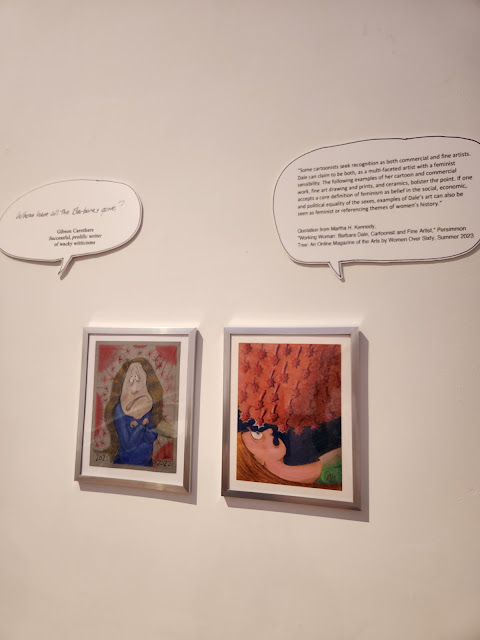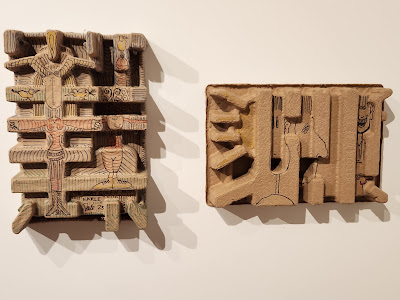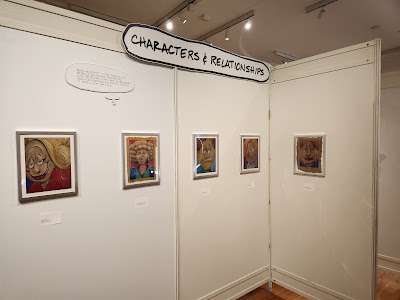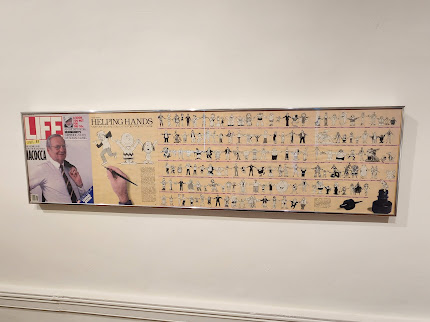reviewed by Manuela Di Franco, Ghent University
Margaret C. Flinn, editor. Drawing
(In) The Feminine. Bande Dessinée and Women. Studies in Comics and Cartoons
series. Columbus: The Ohio State University Press, 2024. 279 pp. <https://ohiostatepress.org/books/titles/9780814215142.html>
Drawing (In) The Feminine raises the important issue
of underrepresentation of women and nonbinary creators in the bande dessinée,
or Francophone (including Africa), industry, a topic whose relevance goes
beyond Franco-Belgian traditions. The volume does not only have the merit of
addressing such an important topic in the field of comics studies, but also opens
a debate on how scholarship can better include and give recognition to
marginalised creators. The volume’s bringing to light underrepresented creators
is achieved by focusing on contribution of female and nonbinary creators and by
challenging the predominant, male-dominated narratives that have populated not
just the comics industry, but also the scholarship. The book’s examination of
how gender dynamics in the comics field caused or contributed to the
marginalization of these creators is combined with a solid socio-cultural
contextualization that helps situate the experience of the specific authors and
case studies approached by the contributors. The volume engages well with existing
scholarship and offers a rich contribution to the field, opening up paths for
future research.
The volume is divided into three
parts, comprised of four essays each for a total of 12 chapters, each by a
different author. Part 1, “Industry, Audience, and Platforms,” tackles the
issue of underrepresentation by examining dynamics between the comics industry
and audiences, to highlight how some creators have attracted more attention
than others. It starts with by retracing the history of bande dessinée from
a gender perspective, to examine if and how the professional path of male and
female creators diverged. Written by Jessica Kohn, the chapter exposes the
limits of focusing on monographic careers, predominantly male, and the negative
consequences such an approach has on our general understanding of the comics
industry, shedding light on issues that have often been overlooked by fans and
scholars. In chapter 2, Sylvain Lesage expands the question by analyzing bd
publishing process as a whole, underlying the importance of recognizing and
addressing the impact of roles such as that of colorists—which “has
traditionally been feminine” (39)—that often go unnoticed despite their
importance. In so doing, Lesage offers an examination of the gendered
distribution of roles in the industry and argues of its relevance to this day
in the legitimization of comics in France. Benoit Crucifix connects these ideas
and adds a historical perspective on the “intermedial connections and exchanges
between comics for adults and for kids” (56), the latter being the field where
women cartoonists and illustrators were more widely employed (and
acknowledged). Crucifix shows through the example of art by Nicole Claveloux
how recognition differs between female and male creators. This third chapter
therefore raises two important issues: that of the recognition of a genre
(children’s comics) and of women’s artists. The final chapter of Part 1, by
Jennifer Howell, addresses the use of comics by female artists as a tool for
social activism, and particularly for challenging the established and
oppressive patriarchal society. Howell provides an exhaustive socio-cultural
contextualization that includes an overview of Moroccan feminism, allowing the
readers to better understand the case studies of the chapter and adding a
contemporary perspective on the issues raised in the previous chapters.
Part 2,
“Geographies of Identities,” centers on bodily experience and its placement in
space. The four chapters of this section deal with different aspects of the
body and the physicality of women’s lived experiences. In chapter 5, Armelle
Blin-Rolland adopts a “medium- and place-specific approach” (97) to examine the
connection between gender and the environment and to add to the field of
“ecographics.” Blin-Rolland does so by using Breton comics as a case study that
shows the links between the construction of a folkloristic, rural, and
feminized identity. The latter is particularly emphasized for the (historical)
importance of women’s experiences with nature, which are particularly relevant
for the Breton case. In chapter 6, Michelle Bumatay focuses on contribution by
women and nonbinary creators within the francophone African and diasporic
context comparing the work by Marguerite Abouet (and Clémenet Oubrerie) with
Joëlle Epée Mandengue’s (known as Elyon). Bumatay argues that the use of the
“feminine plural” in Abouet and Elyon’s comic series serves the purpose to
highlight (and engage with) diversity in gender identities and experiences of
African women. The chapter stresses the importance of acknowledging the
intersectionality of race, gender, and cultural identity, especially to
understand how these creators navigate both African and global contexts and
their contribution to the comics industry. Comics emerged as a medium for
African and diasporic women to express their experiences and challenge
dominant, colonial narratives—showing how comics can give voice to a broad
spectrum of African and diasporic womanhood. Alexandra Gueydan-Turek also
explores the use of comics to give voice to marginalized communities in chapter
7, focused on the 2016 Lebanese comic anthology by the collective Samandal.
Through this case study, the chapter examines the use of comics for political
expression, social activism, and cultural resistance, arguing the significant
role of comics as a platform for marginalized voices and a form of visual
communication that can inspire political change and challenge oppressive
regimes. By analysing Samandal’s work, Gueydan-Turk shows how through visual
and narrative strategies representing political realities, revolutionary comics
transcends borders and can amplify political impact. Finally, the chapter
stresses the importance of paying more scholarly attention to this genre,
especially in the context of contemporary social movements where comics still
have a key role in advocating for political change. The last chapter of part 2,
“Unveiling IVG” by Catriona Macleod, argues comics’ ability of breaking taboos
and offer nuanced portrayal of women’s experiences with abortion, while also
serving as a tool for feminist advocacy. Macleod argues the crucial role of
comics in normalizing conversations about abortion by depicting it as a
personal issue. By normalizing abortion through personal verbal-visual
storytelling, comics humanize the issue and contribute to “unveil” lived
experiences of women. The chapter adds a perspective on feminist comics and
brings to the reader’s attention how they challenge and reshape cultural (and
heteropatriarchal) narratives, aligning with the book’s themes of visibility,
representation, and activism.
Part 3, “Representations and History
(Herstories),” concludes the volume with essays addressing how women have been
represented across century (and genres). It starts with Jacques Dürrenmatt’s
analysis of the depiction of women in early bande dessinées and their
stereotypical image that followed society’s view of women of the time. This
chapter puts the physical representation of women into the socio-historical
context that wanted women attractive and vulnerable, traits that comics
reflected by portraying them with exaggerated feminine features and secondary
roles. Dürrenmatt engages in a visual analysis through case studies to show how
deliberate visual choices reinforced the idea of women’s passive and secondary
role in both society and comics. The analysis is concluded by a call for a
reassessment of early French comics. The evolution of the portrayal of women is
traced by Mark McKinney in his study of the “the Black woman warrior, or
‘Amazon,’ from Dahomey” (198), who follows its transformation from colonial to
postcolonial narratives (chapter 10). The chapter argues that French colonial
comics often exoticized (and eroticized) and simplified the Amazons, while
post-colonial African comics have reclaimed and recontextualized their image as
symbols of empowerment and resistance. McKinney also examines the complex
gender dynamics surrounding the portrayal of the Dahomey Amazons, whose
representation in comics provides a space to explore gender, power, and
resistance, as well as the defiance of the typical representation of women as
passive or subordinate (as seen in the previous chapter). McKinney brings to
light the importance of reclaiming historical narratives through cultural
production and highlights the importance of comics in the process of
decolonization in African arts and literature: by challenging the effects of
colonialism on cultural representations, comics can actively engage with
ongoing discussions of postcolonial narratives—including the European colonial responsibilities.
In the following chapter (chapter 11), Isabelle Delorme adds to the discourse
of women’s representation in comics by analyzing the work of Catel (Catel
Muller), whose feminist biographical bande dessinées have challenged the
historical underrepresentation of women in both history and popular culture.
Delorme examines how Catel’s work blurs the line between art and activism by
advocating with her (bio)graphic novels for greater visibility of women’s
contribution to history, culture, and society. Catel not only brought attention
to marginalized or overlooked female figures, but she also legitimized the
genre of biographies dessinées. Delorme concludes by suggesting that
Catel’s work and collaborative projects points for future directions for both
feminist art and the comics medium. Véronique Bragard concludes this section
with an analysis of how women creators can contribute to the overturning of
“normalized versions of social organization, offering alternative readings of
exploitative systems and hierarchies as well as alternative appropriations of
the comics medium” (240). Through the analysis of Emilie Plateau’s Noire
and her representation of Claudette Colvin, Bragard shows how comics can be
used to re-tell history from a feminist perspective and make a significant
contribution to collective memory. By emphasizing the contributions of women to
the Civil Rights Movement, Plateau’s work challenges the traditional focus on
male leaders and instead gives voice to marginalized female voices, making the
story one of gendered experience and not only of racial injustice.
Overall, the volume achieves its goal
of giving voice to marginalized women and nonbinary creators, although perhaps
with a certain imbalance in favor of the first category. The contributors call
for further research on forgotten or disregarded comics creators, a call that one
can only hope will be welcomed by the scholarship to bring to light the many
underrepresented and marginalized voices left outside of the established,
male-dominated narrative.







































































































































